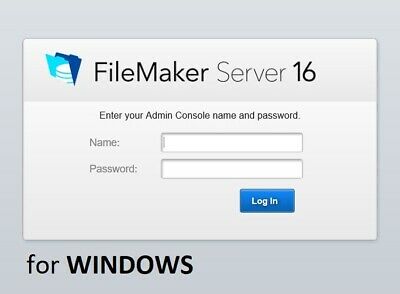

- #Filemaker server 16 requirements full#
- #Filemaker server 16 requirements pro#
- #Filemaker server 16 requirements password#
By default, this account is assigned the Read-Only Access privilege set, but you can assign the account any privilege. The Guest account allows users to access a file without supplying any account information.
#Filemaker server 16 requirements password#
Assign a password when you first begin working in FileMaker Pro.
#Filemaker server 16 requirements full#
You can delete the Admin account, but the file will require at least one account with the Full Access privilege set unless you remove that privilege set completely.īy default, the Admin account has no password. You can rename it, assign it a password, and make the account inactive. By default, this account is assigned the Full Access privilege set. The Admin account permits access to everything in the solution. See Set up external authentication and Set up OAuth identity provider authentication.Įach solution initially contains two accounts: Admin and Guest.

The solution must be hosted with FileMaker Server, and FileMaker Server must be configured to allow external authentication or individual OAuth identity providers.
#Filemaker server 16 requirements pro#
With external authentication (via Open Directory or Active Directory) or with OAuth identity provider authentication, FileMaker Pro stores only user and group names and interacts with an external server or OAuth identity provider to authenticate a user's account and password. All security for a solution is set up in FileMaker Pro without server software, making it the quicker and easier option for managing accounts. With internal authentication (via FileMaker Pro), the account name and password are stored within the solution. Change the password frequently and when specific users no longer require access.įileMaker solutions can authenticate accounts internally, externally, or with an OAuth identity provider. If you must use shared accounts, limit the access capabilities of the privilege sets that the shared accounts use. Note:Shared accounts are a security risk, so use individual accounts instead of shared accounts. See Use functions, scripts, and script triggers to enhance security. Track this information by using auto-enter field settings or by using the Get(AccountName) function in calculations and scripts. This allows you to track who is creating or modifying individual records or taking other actions in your solution. See Define privilege sets.Ĭreate a unique account for each user. Each account is given access privileges based on the associated privilege set. System requirementsįileMaker solutions require users to authenticate with an account name and password combination. Security settings configured within FileMaker Server and FileMaker Cloud are deployment specific and apply to all solutions hosted by the server. Security settings defined within a solution using FileMaker Pro apply only to the information and schema (layouts, tables, fields, relationships, and scripts) stored in that solution. The FileMaker platform employs a unified security model, where the security that you establish for a solution is in effect across all clients. Server monitoring and administration: Admin Console allows you to monitor solution access, disconnect idle users, and create backups of your solutions. You can also require Secure Socket Layer (SSL) encryption of data between FileMaker Server or FileMaker Cloud and FileMaker Pro, FileMaker Go, FileMaker WebDirect, and ODBC and JDBC client applications. Data encryption on the disk and over the wire: You can encrypt the data stored within a FileMaker solution. You can define as many privilege sets as needed. Access control with privilege sets: You define permissions that determine levels of access to your solution. Users can also authenticate via Active Directory, Open Directory, or OAuth identity providers. Authentication with accounts: FileMaker encrypts credentials stored within solutions so the credentials are protected. The FileMaker platform's features help you control data access, operations, and development within a FileMaker file.






 0 kommentar(er)
0 kommentar(er)
